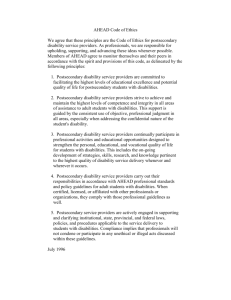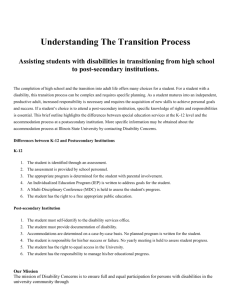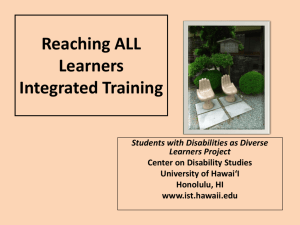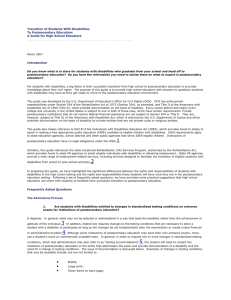Faculty Integrated Pre Survey - Students with Disabilities as Diverse
advertisement
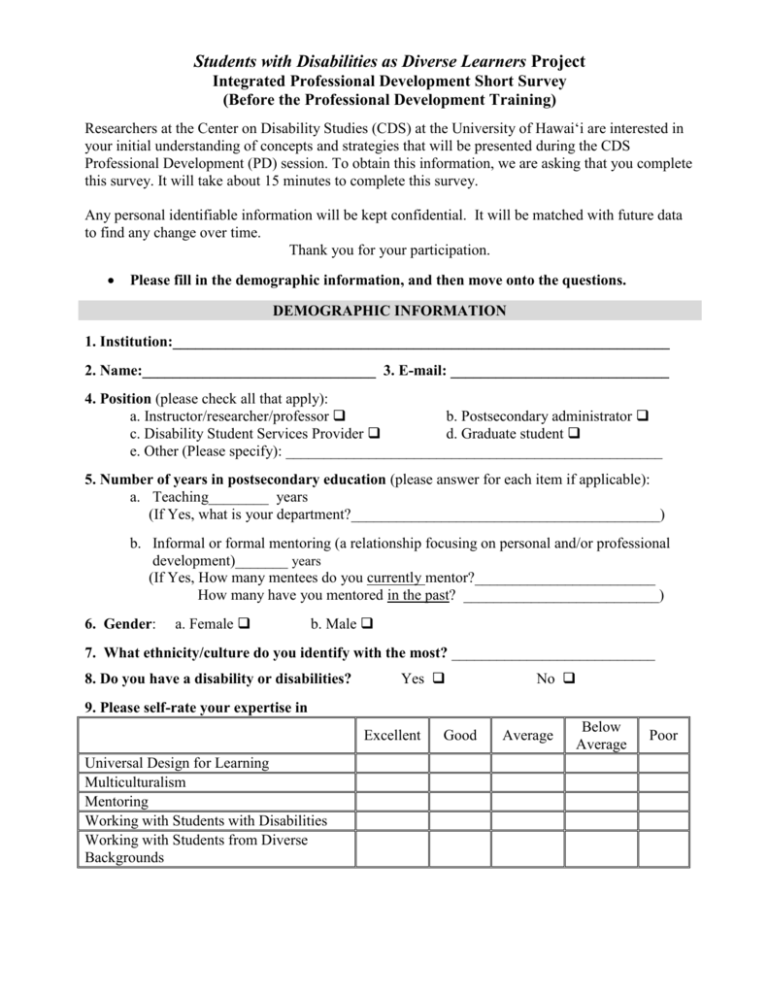
Students with Disabilities as Diverse Learners Project Integrated Professional Development Short Survey (Before the Professional Development Training) Researchers at the Center on Disability Studies (CDS) at the University of Hawai‘i are interested in your initial understanding of concepts and strategies that will be presented during the CDS Professional Development (PD) session. To obtain this information, we are asking that you complete this survey. It will take about 15 minutes to complete this survey. Any personal identifiable information will be kept confidential. It will be matched with future data to find any change over time. Thank you for your participation. Please fill in the demographic information, and then move onto the questions. DEMOGRAPHIC INFORMATION 1. Institution:__________________________________________________________________ 2. Name:_______________________________ 3. E-mail: _____________________________ 4. Position (please check all that apply): a. Instructor/researcher/professor b. Postsecondary administrator c. Disability Student Services Provider d. Graduate student e. Other (Please specify): __________________________________________________ 5. Number of years in postsecondary education (please answer for each item if applicable): a. Teaching________ years (If Yes, what is your department?_________________________________________) b. Informal or formal mentoring (a relationship focusing on personal and/or professional development)_______ years (If Yes, How many mentees do you currently mentor?________________________ How many have you mentored in the past? __________________________) 6. Gender: a. Female b. Male 7. What ethnicity/culture do you identify with the most? ___________________________ 8. Do you have a disability or disabilities? Yes No 9. Please self-rate your expertise in Excellent Universal Design for Learning Multiculturalism Mentoring Working with Students with Disabilities Working with Students from Diverse Backgrounds Good Average Below Average Poor 2 * Please respond to each question as indicated. ___1. Diversity includes: a. Ethnicity b. Gender c. Disability d. All of the above e. A and B ___2. Only a student with a disability has the right to disclose whether they have a disability. a. True b. False ___3. Courses that are universally designed: a. Only benefit students with disabilities b. Cannot be delivered online c. May help all students learn better d. Are not appropriate in postsecondary education institutions ___4. A postsecondary faculty mentor accounts for: a. Cultural differences b. Disability identity c. Academic environment d. A, B, and C ___5. Universal Design is the design of products and environments to be usable by everyone, to the greatest extent possible, without the need for adaptation or specialized design. a. True b. False ___6. Hidden disabilities include: a. Chronic conditions b. Multiple chemical sensitivities c. Psychological disabilities d. All of the above e. None of the above ___7. UDL takes into account issues of: a. Space b. Student grades c. Meeting institutional requirements d. Teaching loads ___8. An instructor’s cultural background may influence his or her teaching styles. a. True b. False 3 ___9. Guided notes: a. Include additional resources such as websites and references b. Use symbols to denote important points, examples, or questions c. Require extensive writing d. A and B ___10. In the medical model, disability is conceived as residing in an individual who is broken or sick and in need of fixing or curing. a. True b. False ___11. In a mentoring situation, faculty may: a. Provide expertise in their discipline of study b. Recruit research subjects c. Learn about disability issues from their mentees d. Be a mentee as well as a mentor e. A, C, and D ___12. Cultural diversity in a postsecondary environment includes: a. Immigrant status b. Cultural and linguistic diversity c. Non-traditional students d. Students with disabilities e. All of the above 13. List 3 principles included in courses that are universally designed: a. Multiple Means of ____________________________ b. Multiple Means of ____________________________ c. Multiple Means of ____________________________ ___14. Many individuals with disabilities believe in disability culture. a. True b. False ___15. Failure to provide appropriate accommodations is a form of discrimination. a. True b. False ___16. Cultural diversity includes: a. Military identity b. Geographic identity c. Sexual identity d. Disability identity e. All of the above ___17. Applying UDL principles in the classroom requires the use of high-cost technologies. a. True b. False 4 ___18. Mentoring can be conducted: a. In-person b. Via the Internet c. On the telephone d. Via video conferences e. All of the above ___19. Confidentiality in mentoring is required. a. True b. False ___20. The Pause Procedure emphasizes periodic breaks of a couple of minutes for students to review notes and discuss content. a. True b. False PLEASE RETURN TO Project Staff Or Steve Brown 1776 University Ave. UA 4-6 Honolulu, Hawaii 96822 sebrown@hawaii.edu 808-956-0996 For more information on this project, see www.ist.hawaii.edu Thank You for Completing the Survey




